transmission FORD EDGE 2018 Owners Manual
[x] Cancel search | Manufacturer: FORD, Model Year: 2018, Model line: EDGE, Model: FORD EDGE 2018Pages: 557, PDF Size: 7.02 MB
Page 6 of 557
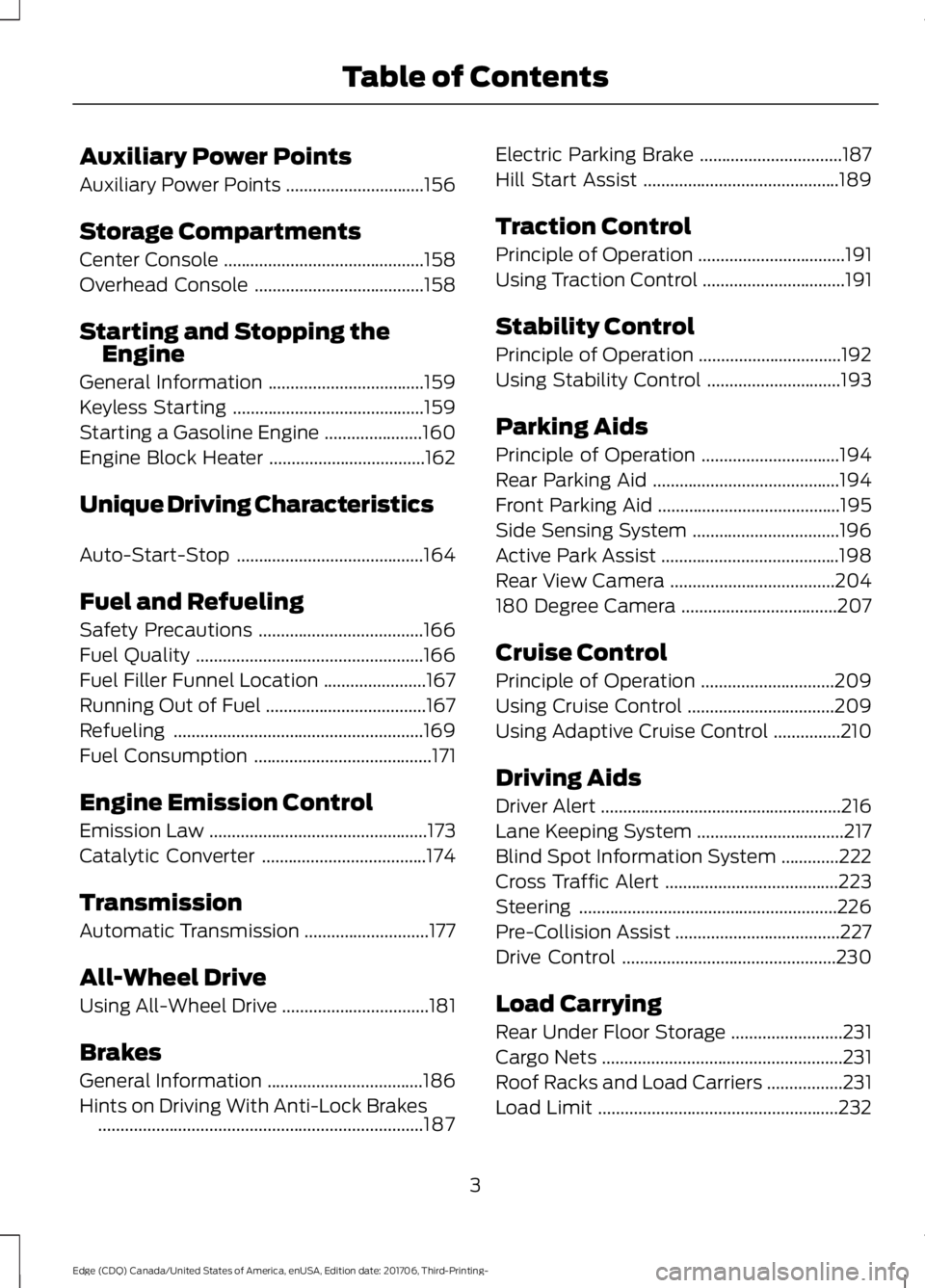
Auxiliary Power Points
Auxiliary Power Points
...............................156
Storage Compartments
Center Console .............................................
158
Overhead Console ......................................
158
Starting and Stopping the Engine
General Information ...................................
159
Keyless Starting ...........................................
159
Starting a Gasoline Engine ......................
160
Engine Block Heater ...................................
162
Unique Driving Characteristics
Auto-Start-Stop ..........................................
164
Fuel and Refueling
Safety Precautions .....................................
166
Fuel Quality ...................................................
166
Fuel Filler Funnel Location .......................
167
Running Out of Fuel ....................................
167
Refueling ........................................................
169
Fuel Consumption ........................................
171
Engine Emission Control
Emission Law .................................................
173
Catalytic Converter .....................................
174
Transmission
Automatic Transmission ............................
177
All-Wheel Drive
Using All-Wheel Drive .................................
181
Brakes
General Information ...................................
186
Hints on Driving With Anti-Lock Brakes ........................................................................\
.
187 Electric Parking Brake
................................
187
Hill Start Assist ............................................
189
Traction Control
Principle of Operation .................................
191
Using Traction Control ................................
191
Stability Control
Principle of Operation ................................
192
Using Stability Control ..............................
193
Parking Aids
Principle of Operation ...............................
194
Rear Parking Aid ..........................................
194
Front Parking Aid .........................................
195
Side Sensing System .................................
196
Active Park Assist ........................................
198
Rear View Camera .....................................
204
180 Degree Camera ...................................
207
Cruise Control
Principle of Operation ..............................
209
Using Cruise Control .................................
209
Using Adaptive Cruise Control ...............
210
Driving Aids
Driver Alert ......................................................
216
Lane Keeping System .................................
217
Blind Spot Information System .............
222
Cross Traffic Alert .......................................
223
Steering ..........................................................
226
Pre-Collision Assist .....................................
227
Drive Control ................................................
230
Load Carrying
Rear Under Floor Storage .........................
231
Cargo Nets ......................................................
231
Roof Racks and Load Carriers .................
231
Load Limit ......................................................
232
3
Edge (CDQ) Canada/United States of America, enUSA, Edition date: 201706, Third-Printing- Table of Contents
Page 7 of 557

Towing
Towing a Trailer
...........................................238
Trailer Sway Control ..................................
239
Recommended Towing Weights ..........
239
Essential Towing Checks ..........................
241
Towing the Vehicle on Four Wheels - 6-Speed Automatic Transmission -
6F50/6F55 ...............................................
243
Towing the Vehicle on Four Wheels - 6-Speed Automatic Transmission -
6F35 ............................................................
244
Driving Hints
Breaking-In ....................................................
246
Economical Driving ....................................
246
Cold Weather Precautions ......................
246
Driving Through Water ..............................
246
Floor Mats ......................................................
247
Roadside Emergencies
Roadside Assistance .................................
248
Hazard Flashers ..........................................
249
Fuel Shutoff ..................................................
249
Jump Starting the Vehicle .......................
250
Post-Crash Alert System ..........................
251
Transporting the Vehicle ..........................
252
Customer Assistance
Getting the Services You Need ..............
253
In California (U.S. Only) ...........................
254
The Better Business Bureau (BBB) Auto Line Program (U.S. Only) .....................
255
Utilizing the Mediation/Arbitration Program (Canada Only) ......................
256
Getting Assistance Outside the U.S. and Canada .......................................................
256
Ordering Additional Owner's Literature ........................................................................\
258
Reporting Safety Defects (U.S. Only) ........................................................................\
258
Reporting Safety Defects (Canada Only) ........................................................................\
258 Fuses
Fuse Specification Chart
.........................
260
Changing a Fuse ..........................................
270
Maintenance
General Information ...................................
272
Opening and Closing the Hood ..............
272
Under Hood Overview - 2.0L EcoBoost™ ........................................................................\
.
273
Under Hood Overview - 2.7L EcoBoost™ ........................................................................\
274
Under Hood Overview - 3.5L ..................
275
Engine Oil Dipstick - 2.0L EcoBoost™ ........................................................................\
.
277
Engine Oil Dipstick - 2.7L EcoBoost™ ........................................................................\
.
277
Engine Oil Dipstick - 3.5L ..........................
277
Engine Oil Check ..........................................
277
Oil Change Indicator Reset ......................
279
Engine Coolant Check ...............................
279
Automatic Transmission Fluid Check - 2.0L EcoBoost™ .....................................
283
Automatic Transmission Fluid Check - 2.7L EcoBoost™/3.5L ...........................
284
Brake Fluid Check .......................................
286
Power Steering Fluid Check ...................
286
Washer Fluid Check ...................................
286
Fuel Filter .......................................................
287
Changing the 12V Battery ........................
287
Checking the Wiper Blades ....................
288
Changing the Wiper Blades ....................
289
Adjusting the Headlamps .......................
289
Removing a Headlamp ..............................
291
Changing a Bulb ...........................................
291
Bulb Specification Chart ..........................
293
Changing the Engine Air Filter ...............
295
Vehicle Care
General Information ..................................
296
Cleaning Products ......................................
296
4
Edge (CDQ) Canada/United States of America, enUSA, Edition date: 201706, Third-Printing- Table of Contents
Page 8 of 557
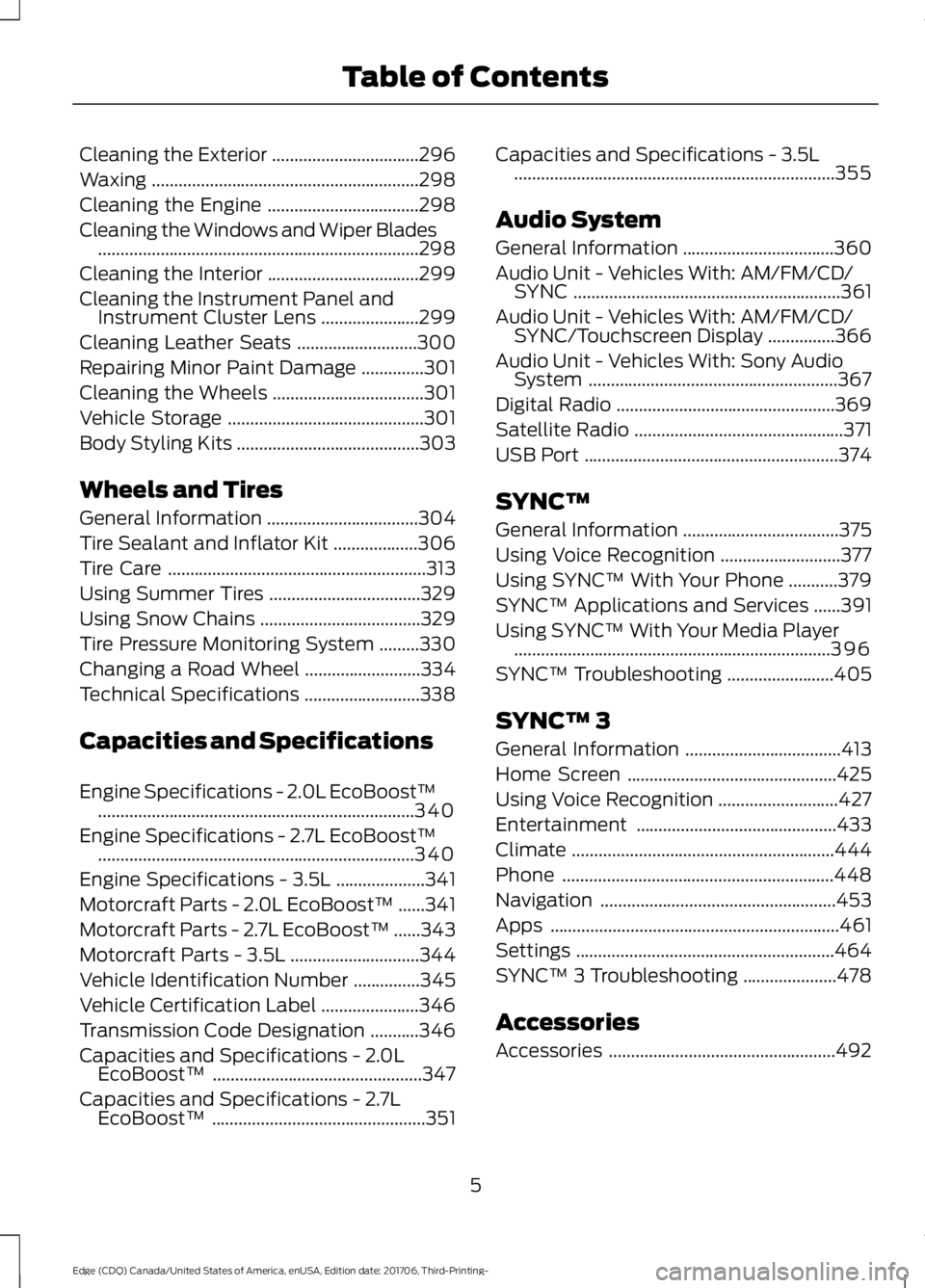
Cleaning the Exterior
.................................296
Waxing ............................................................
298
Cleaning the Engine ..................................
298
Cleaning the Windows and Wiper Blades ........................................................................\
298
Cleaning the Interior ..................................
299
Cleaning the Instrument Panel and Instrument Cluster Lens ......................
299
Cleaning Leather Seats ...........................
300
Repairing Minor Paint Damage ..............
301
Cleaning the Wheels ..................................
301
Vehicle Storage ............................................
301
Body Styling Kits .........................................
303
Wheels and Tires
General Information ..................................
304
Tire Sealant and Inflator Kit ...................
306
Tire Care ..........................................................
313
Using Summer Tires ..................................
329
Using Snow Chains ....................................
329
Tire Pressure Monitoring System .........
330
Changing a Road Wheel ..........................
334
Technical Specifications ..........................
338
Capacities and Specifications
Engine Specifications - 2.0L EcoBoost™ .......................................................................
340
Engine Specifications - 2.7L EcoBoost™ .......................................................................
340
Engine Specifications - 3.5L ....................
341
Motorcraft Parts - 2.0L EcoBoost™ ......
341
Motorcraft Parts - 2.7L EcoBoost™ ......
343
Motorcraft Parts - 3.5L .............................
344
Vehicle Identification Number ...............
345
Vehicle Certification Label ......................
346
Transmission Code Designation ...........
346
Capacities and Specifications - 2.0L EcoBoost™ ...............................................
347
Capacities and Specifications - 2.7L EcoBoost™ ................................................
351Capacities and Specifications - 3.5L
........................................................................\
355
Audio System
General Information ..................................
360
Audio Unit - Vehicles With: AM/FM/CD/ SYNC ............................................................
361
Audio Unit - Vehicles With: AM/FM/CD/ SYNC/Touchscreen Display ...............
366
Audio Unit - Vehicles With: Sony Audio System ........................................................
367
Digital Radio .................................................
369
Satellite Radio ...............................................
371
USB Port .........................................................
374
SYNC™
General Information ...................................
375
Using Voice Recognition ...........................
377
Using SYNC™ With Your Phone ...........
379
SYNC™ Applications and Services ......
391
Using SYNC™ With Your Media Player .......................................................................
396
SYNC™ Troubleshooting ........................
405
SYNC™ 3
General Information ...................................
413
Home Screen ...............................................
425
Using Voice Recognition ...........................
427
Entertainment .............................................
433
Climate ...........................................................
444
Phone .............................................................
448
Navigation .....................................................
453
Apps .................................................................
461
Settings ..........................................................
464
SYNC™ 3 Troubleshooting .....................
478
Accessories
Accessories ...................................................
492
5
Edge (CDQ) Canada/United States of America, enUSA, Edition date: 201706, Third-Printing- Table of Contents
Page 16 of 557
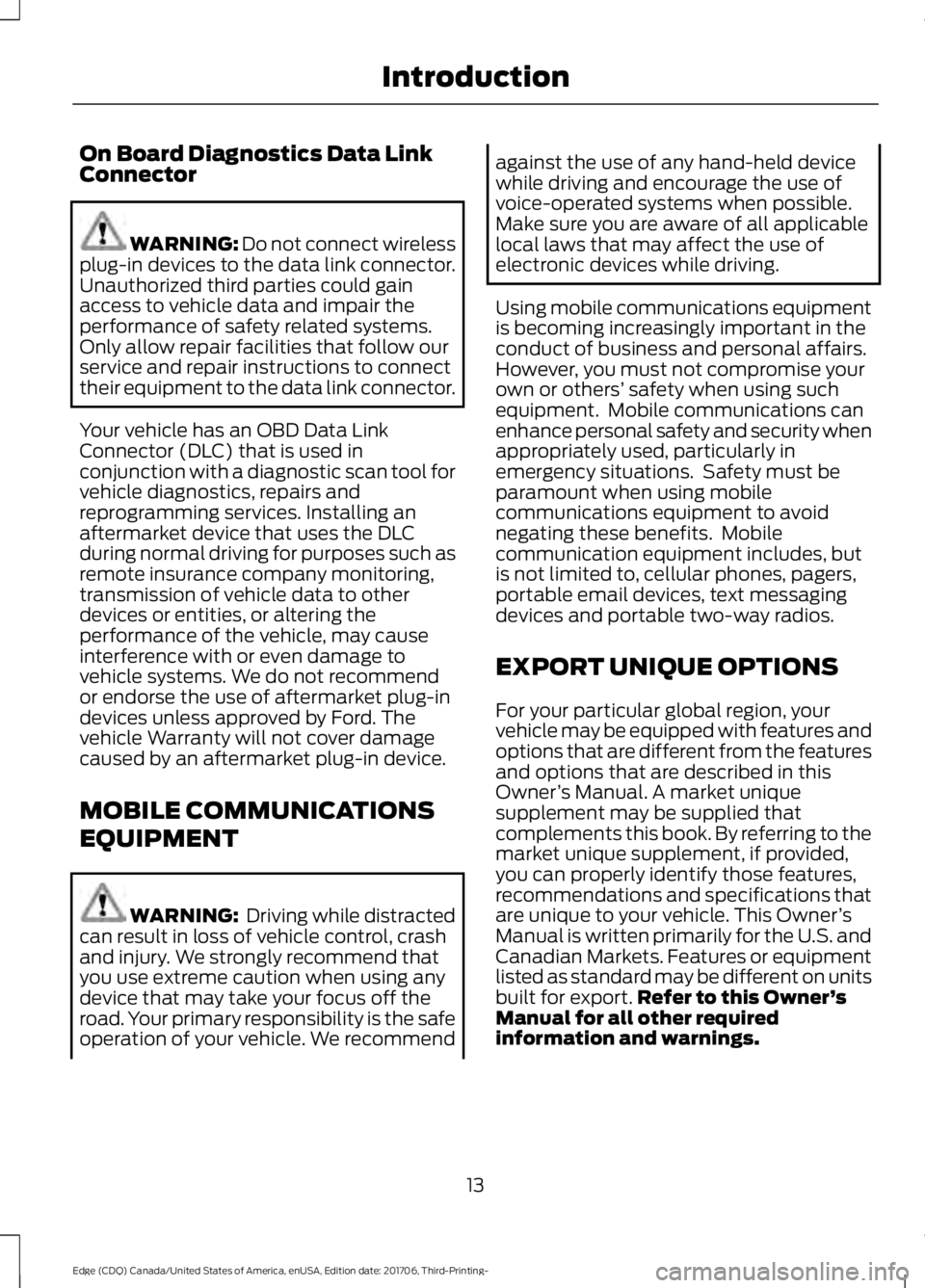
On Board Diagnostics Data Link
Connector
WARNING: Do not connect wireless
plug-in devices to the data link connector.
Unauthorized third parties could gain
access to vehicle data and impair the
performance of safety related systems.
Only allow repair facilities that follow our
service and repair instructions to connect
their equipment to the data link connector.
Your vehicle has an OBD Data Link
Connector (DLC) that is used in
conjunction with a diagnostic scan tool for
vehicle diagnostics, repairs and
reprogramming services. Installing an
aftermarket device that uses the DLC
during normal driving for purposes such as
remote insurance company monitoring,
transmission of vehicle data to other
devices or entities, or altering the
performance of the vehicle, may cause
interference with or even damage to
vehicle systems. We do not recommend
or endorse the use of aftermarket plug-in
devices unless approved by Ford. The
vehicle Warranty will not cover damage
caused by an aftermarket plug-in device.
MOBILE COMMUNICATIONS
EQUIPMENT WARNING: Driving while distracted
can result in loss of vehicle control, crash
and injury. We strongly recommend that
you use extreme caution when using any
device that may take your focus off the
road. Your primary responsibility is the safe
operation of your vehicle. We recommend against the use of any hand-held device
while driving and encourage the use of
voice-operated systems when possible.
Make sure you are aware of all applicable
local laws that may affect the use of
electronic devices while driving.
Using mobile communications equipment
is becoming increasingly important in the
conduct of business and personal affairs.
However, you must not compromise your
own or others’
safety when using such
equipment. Mobile communications can
enhance personal safety and security when
appropriately used, particularly in
emergency situations. Safety must be
paramount when using mobile
communications equipment to avoid
negating these benefits. Mobile
communication equipment includes, but
is not limited to, cellular phones, pagers,
portable email devices, text messaging
devices and portable two-way radios.
EXPORT UNIQUE OPTIONS
For your particular global region, your
vehicle may be equipped with features and
options that are different from the features
and options that are described in this
Owner ’s Manual. A market unique
supplement may be supplied that
complements this book. By referring to the
market unique supplement, if provided,
you can properly identify those features,
recommendations and specifications that
are unique to your vehicle. This Owner ’s
Manual is written primarily for the U.S. and
Canadian Markets. Features or equipment
listed as standard may be different on units
built for export. Refer to this Owner ’s
Manual for all other required
information and warnings.
13
Edge (CDQ) Canada/United States of America, enUSA, Edition date: 201706, Third-Printing- Introduction
Page 42 of 557
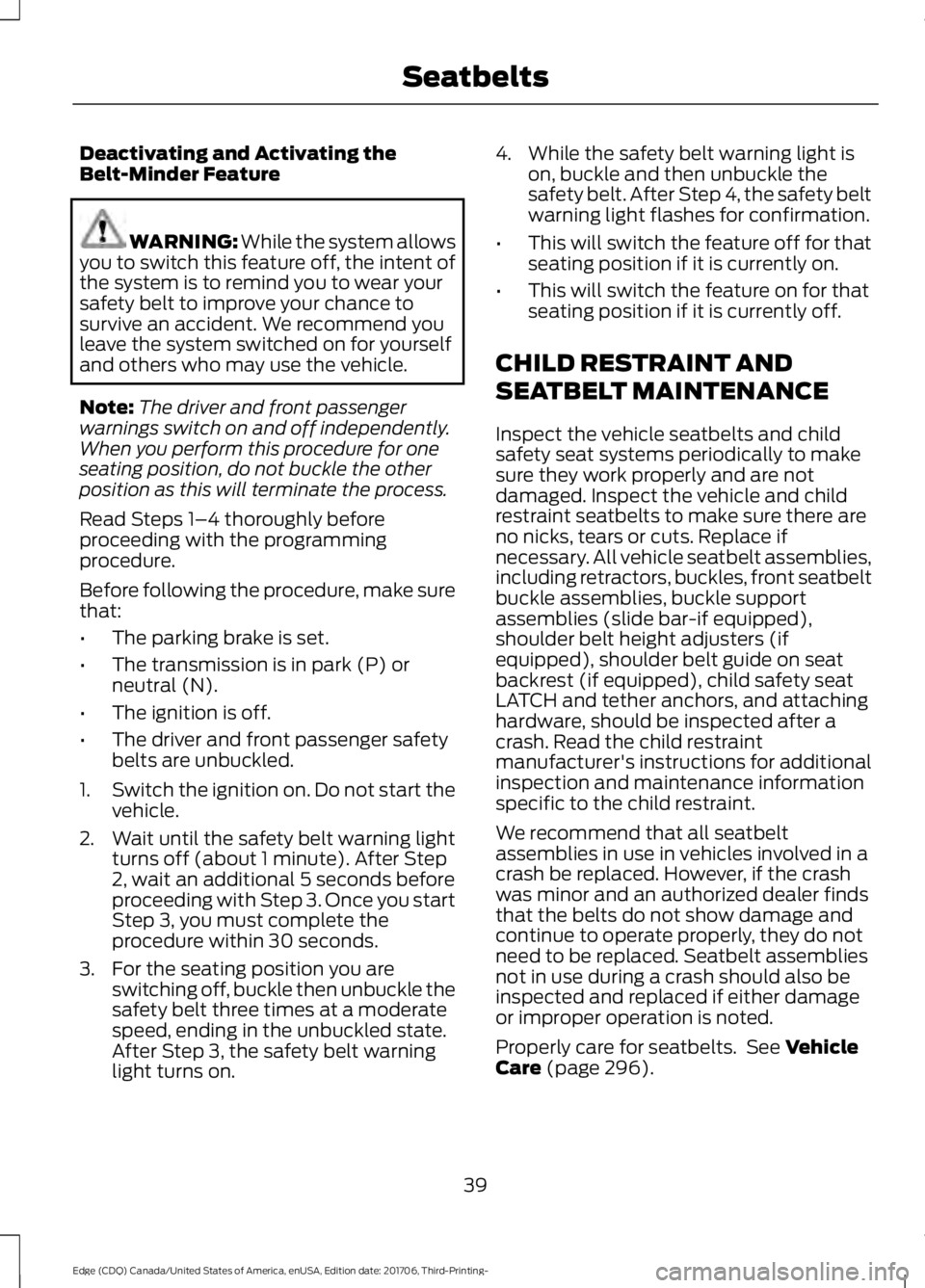
Deactivating and Activating the
Belt-Minder Feature
WARNING: While the system allows
you to switch this feature off, the intent of
the system is to remind you to wear your
safety belt to improve your chance to
survive an accident. We recommend you
leave the system switched on for yourself
and others who may use the vehicle.
Note: The driver and front passenger
warnings switch on and off independently.
When you perform this procedure for one
seating position, do not buckle the other
position as this will terminate the process.
Read Steps 1–4 thoroughly before
proceeding with the programming
procedure.
Before following the procedure, make sure
that:
• The parking brake is set.
• The transmission is in park (P) or
neutral (N).
• The ignition is off.
• The driver and front passenger safety
belts are unbuckled.
1. Switch the ignition on. Do not start the
vehicle.
2. Wait until the safety belt warning light turns off (about 1 minute). After Step
2, wait an additional 5 seconds before
proceeding with Step 3. Once you start
Step 3, you must complete the
procedure within 30 seconds.
3. For the seating position you are switching off, buckle then unbuckle the
safety belt three times at a moderate
speed, ending in the unbuckled state.
After Step 3, the safety belt warning
light turns on. 4. While the safety belt warning light is
on, buckle and then unbuckle the
safety belt. After Step 4, the safety belt
warning light flashes for confirmation.
• This will switch the feature off for that
seating position if it is currently on.
• This will switch the feature on for that
seating position if it is currently off.
CHILD RESTRAINT AND
SEATBELT MAINTENANCE
Inspect the vehicle seatbelts and child
safety seat systems periodically to make
sure they work properly and are not
damaged. Inspect the vehicle and child
restraint seatbelts to make sure there are
no nicks, tears or cuts. Replace if
necessary. All vehicle seatbelt assemblies,
including retractors, buckles, front seatbelt
buckle assemblies, buckle support
assemblies (slide bar-if equipped),
shoulder belt height adjusters (if
equipped), shoulder belt guide on seat
backrest (if equipped), child safety seat
LATCH and tether anchors, and attaching
hardware, should be inspected after a
crash. Read the child restraint
manufacturer's instructions for additional
inspection and maintenance information
specific to the child restraint.
We recommend that all seatbelt
assemblies in use in vehicles involved in a
crash be replaced. However, if the crash
was minor and an authorized dealer finds
that the belts do not show damage and
continue to operate properly, they do not
need to be replaced. Seatbelt assemblies
not in use during a crash should also be
inspected and replaced if either damage
or improper operation is noted.
Properly care for seatbelts. See
Vehicle
Care (page 296).
39
Edge (CDQ) Canada/United States of America, enUSA, Edition date: 201706, Third-Printing- Seatbelts
Page 58 of 557

Car Finder
Press the button twice within
three seconds. The horn sounds
and the direction indicators
flash. We recommend you use this method
to locate your vehicle, rather than using
the panic alarm.
Sounding a Panic Alarm
Note: The panic alarm only operates when
the ignition is off. Press the button to sound the
panic alarm. Press the button
again or switch the ignition on to
deactivate.
Remote Start (If Equipped) WARNING:
To avoid exhaust fumes,
do not use remote start if your vehicle is
parked indoors or in areas that are not well
ventilated.
Note: Do not use remote start if your fuel
level is low. The remote start button is on the
transmitter.
This feature allows you to start your
vehicle from outside the vehicle. The
transmitter has an extended operating
range.
Vehicles with automatic climate control
can be configured to operate when the
vehicle is remote started. See Automatic
Climate Control
(page 129).
Many states and provinces have
restrictions for the use of remote start.
Check your local and state or provincial
laws for specific requirements regarding
remote start systems. The remote start system does not work if:
•
The ignition is on.
• The alarm system is triggered.
• You switch off the feature in the
information display. See
General
Information (page 104).
• The hood is open.
• The transmission is not in park (P).
• The vehicle battery voltage is too low.
• The service engine soon light is on.
Remote Starting Your Vehicle
Note: You must press each button within
three seconds of each other. If you do not
follow this sequence, your vehicle does not
start remotely, the direction indicators do
not flash twice and the horn does not sound. To remote start your vehicle:
1. Press the lock button.
2. Press the remote start button twice.
The exterior lamps flash twice.
The horn sounds if the system fails to start.
See
General Information (page 104).
The power windows do not work during
the remote start and the radio does not
turn on automatically.
The parking lamps remain on and the
vehicle will run for 5, 10, or 15 minutes,
depending on the setting. See
General
Information (page 104).
55
Edge (CDQ) Canada/United States of America, enUSA, Edition date: 201706, Third-Printing- Keys and Remote ControlsE138623 E138624 E138625 E138626
Page 69 of 557
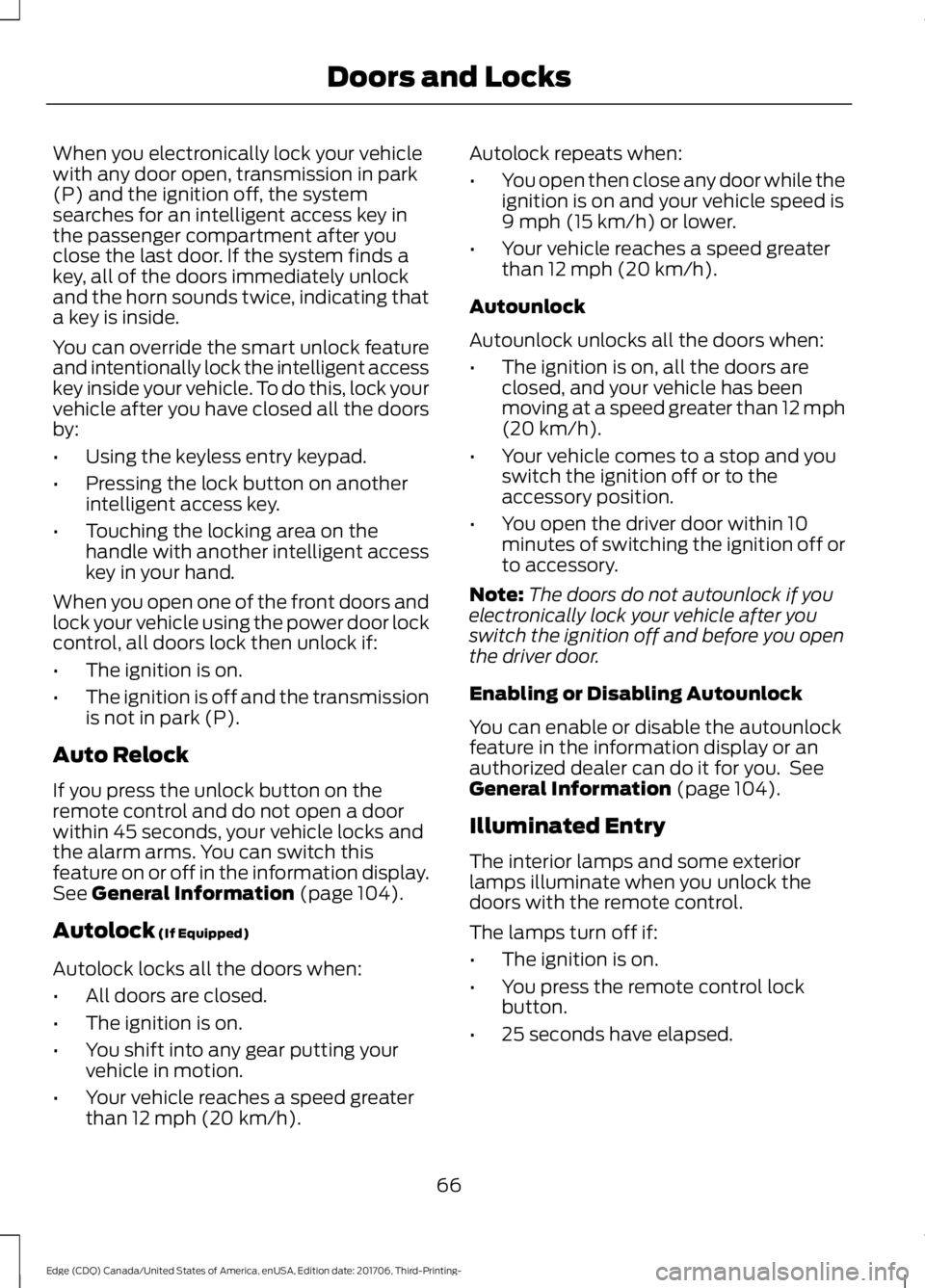
When you electronically lock your vehicle
with any door open, transmission in park
(P) and the ignition off, the system
searches for an intelligent access key in
the passenger compartment after you
close the last door. If the system finds a
key, all of the doors immediately unlock
and the horn sounds twice, indicating that
a key is inside.
You can override the smart unlock feature
and intentionally lock the intelligent access
key inside your vehicle. To do this, lock your
vehicle after you have closed all the doors
by:
•
Using the keyless entry keypad.
• Pressing the lock button on another
intelligent access key.
• Touching the locking area on the
handle with another intelligent access
key in your hand.
When you open one of the front doors and
lock your vehicle using the power door lock
control, all doors lock then unlock if:
• The ignition is on.
• The ignition is off and the transmission
is not in park (P).
Auto Relock
If you press the unlock button on the
remote control and do not open a door
within 45 seconds, your vehicle locks and
the alarm arms. You can switch this
feature on or off in the information display.
See General Information (page 104).
Autolock
(If Equipped)
Autolock locks all the doors when:
• All doors are closed.
• The ignition is on.
• You shift into any gear putting your
vehicle in motion.
• Your vehicle reaches a speed greater
than
12 mph (20 km/h). Autolock repeats when:
•
You open then close any door while the
ignition is on and your vehicle speed is
9 mph (15 km/h)
or lower.
• Your vehicle reaches a speed greater
than
12 mph (20 km/h).
Autounlock
Autounlock unlocks all the doors when:
• The ignition is on, all the doors are
closed, and your vehicle has been
moving at a speed greater than 12 mph
(20 km/h)
.
• Your vehicle comes to a stop and you
switch the ignition off or to the
accessory position.
• You open the driver door within 10
minutes of switching the ignition off or
to accessory.
Note: The doors do not autounlock if you
electronically lock your vehicle after you
switch the ignition off and before you open
the driver door.
Enabling or Disabling Autounlock
You can enable or disable the autounlock
feature in the information display or an
authorized dealer can do it for you. See
General Information
(page 104).
Illuminated Entry
The interior lamps and some exterior
lamps illuminate when you unlock the
doors with the remote control.
The lamps turn off if:
• The ignition is on.
• You press the remote control lock
button.
• 25 seconds have elapsed.
66
Edge (CDQ) Canada/United States of America, enUSA, Edition date: 201706, Third-Printing- Doors and Locks
Page 74 of 557
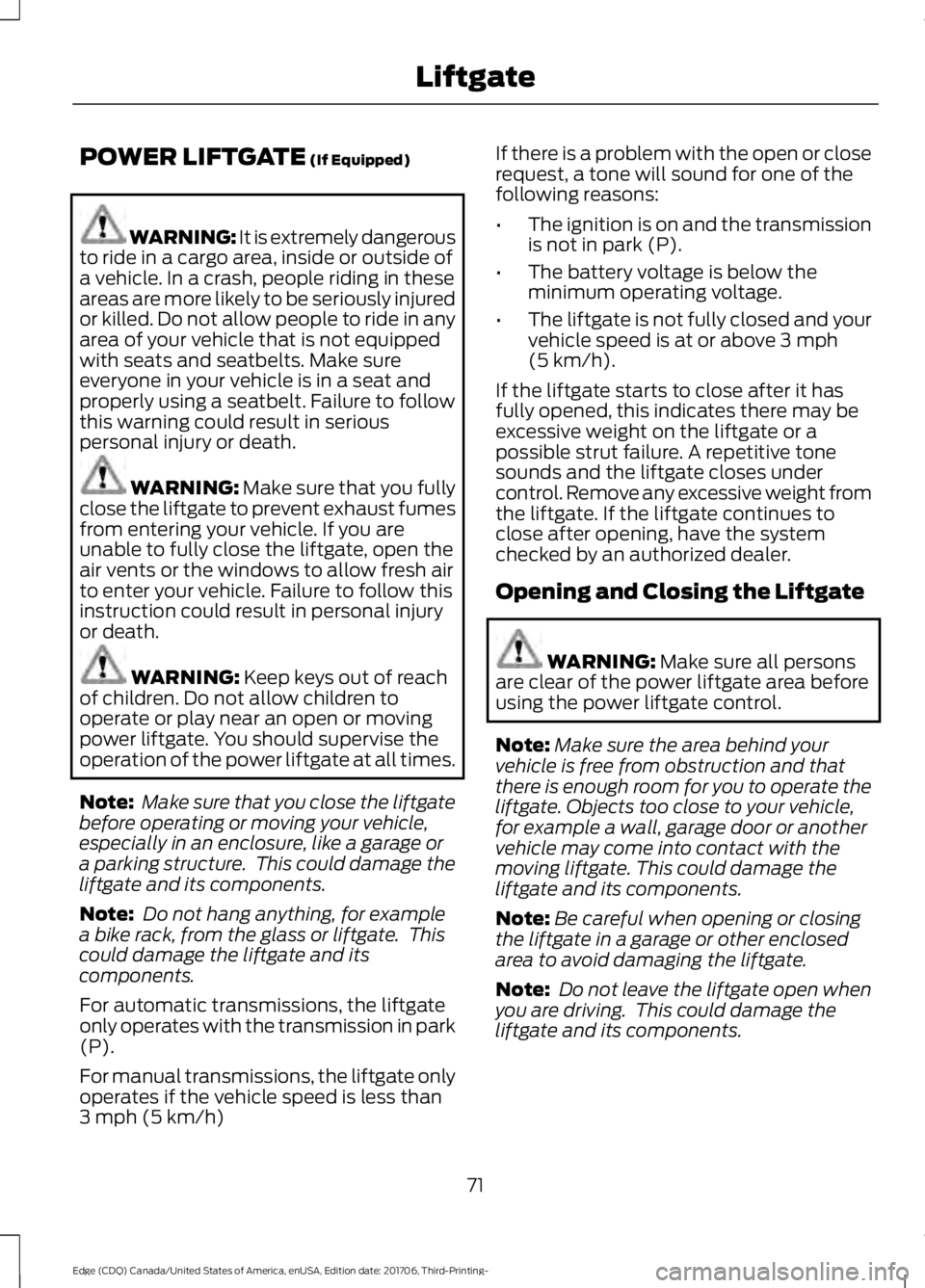
POWER LIFTGATE (If Equipped)
WARNING: It is extremely dangerous
to ride in a cargo area, inside or outside of
a vehicle. In a crash, people riding in these
areas are more likely to be seriously injured
or killed. Do not allow people to ride in any
area of your vehicle that is not equipped
with seats and seatbelts. Make sure
everyone in your vehicle is in a seat and
properly using a seatbelt. Failure to follow
this warning could result in serious
personal injury or death. WARNING:
Make sure that you fully
close the liftgate to prevent exhaust fumes
from entering your vehicle. If you are
unable to fully close the liftgate, open the
air vents or the windows to allow fresh air
to enter your vehicle. Failure to follow this
instruction could result in personal injury
or death. WARNING:
Keep keys out of reach
of children. Do not allow children to
operate or play near an open or moving
power liftgate. You should supervise the
operation of the power liftgate at all times.
Note: Make sure that you close the liftgate
before operating or moving your vehicle,
especially in an enclosure, like a garage or
a parking structure. This could damage the
liftgate and its components.
Note: Do not hang anything, for example
a bike rack, from the glass or liftgate. This
could damage the liftgate and its
components.
For automatic transmissions, the liftgate
only operates with the transmission in park
(P).
For manual transmissions, the liftgate only
operates if the vehicle speed is less than
3 mph (5 km/h) If there is a problem with the open or close
request, a tone will sound for one of the
following reasons:
•
The ignition is on and the transmission
is not in park (P).
• The battery voltage is below the
minimum operating voltage.
• The liftgate is not fully closed and your
vehicle speed is at or above
3 mph
(5 km/h).
If the liftgate starts to close after it has
fully opened, this indicates there may be
excessive weight on the liftgate or a
possible strut failure. A repetitive tone
sounds and the liftgate closes under
control. Remove any excessive weight from
the liftgate. If the liftgate continues to
close after opening, have the system
checked by an authorized dealer.
Opening and Closing the Liftgate WARNING:
Make sure all persons
are clear of the power liftgate area before
using the power liftgate control.
Note: Make sure the area behind your
vehicle is free from obstruction and that
there is enough room for you to operate the
liftgate. Objects too close to your vehicle,
for example a wall, garage door or another
vehicle may come into contact with the
moving liftgate. This could damage the
liftgate and its components.
Note: Be careful when opening or closing
the liftgate in a garage or other enclosed
area to avoid damaging the liftgate.
Note: Do not leave the liftgate open when
you are driving. This could damage the
liftgate and its components.
71
Edge (CDQ) Canada/United States of America, enUSA, Edition date: 201706, Third-Printing- Liftgate
Page 75 of 557
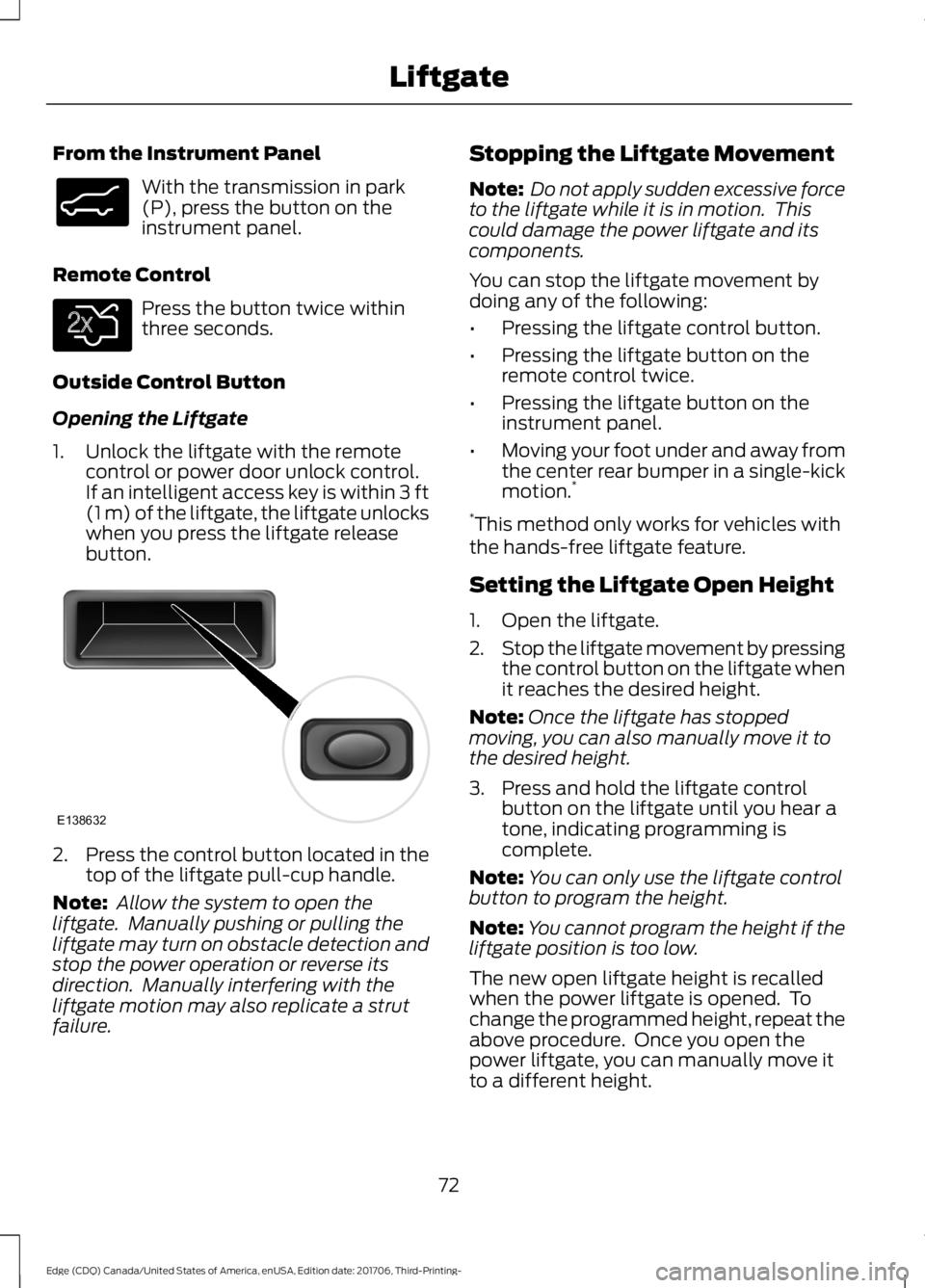
From the Instrument Panel
With the transmission in park
(P), press the button on the
instrument panel.
Remote Control Press the button twice within
three seconds.
Outside Control Button
Opening the Liftgate
1. Unlock the liftgate with the remote control or power door unlock control.
If an intelligent access key is within 3 ft
(1 m) of the liftgate, the liftgate unlocks
when you press the liftgate release
button. 2.
Press the control button located in the
top of the liftgate pull-cup handle.
Note: Allow the system to open the
liftgate. Manually pushing or pulling the
liftgate may turn on obstacle detection and
stop the power operation or reverse its
direction. Manually interfering with the
liftgate motion may also replicate a strut
failure. Stopping the Liftgate Movement
Note:
Do not apply sudden excessive force
to the liftgate while it is in motion. This
could damage the power liftgate and its
components.
You can stop the liftgate movement by
doing any of the following:
• Pressing the liftgate control button.
• Pressing the liftgate button on the
remote control twice.
• Pressing the liftgate button on the
instrument panel.
• Moving your foot under and away from
the center rear bumper in a single-kick
motion. *
* This method only works for vehicles with
the hands-free liftgate feature.
Setting the Liftgate Open Height
1. Open the liftgate.
2. Stop the liftgate movement by pressing
the control button on the liftgate when
it reaches the desired height.
Note: Once the liftgate has stopped
moving, you can also manually move it to
the desired height.
3. Press and hold the liftgate control button on the liftgate until you hear a
tone, indicating programming is
complete.
Note: You can only use the liftgate control
button to program the height.
Note: You cannot program the height if the
liftgate position is too low.
The new open liftgate height is recalled
when the power liftgate is opened. To
change the programmed height, repeat the
above procedure. Once you open the
power liftgate, you can manually move it
to a different height.
72
Edge (CDQ) Canada/United States of America, enUSA, Edition date: 201706, Third-Printing- LiftgateE138633 E138630 E138632
Page 90 of 557
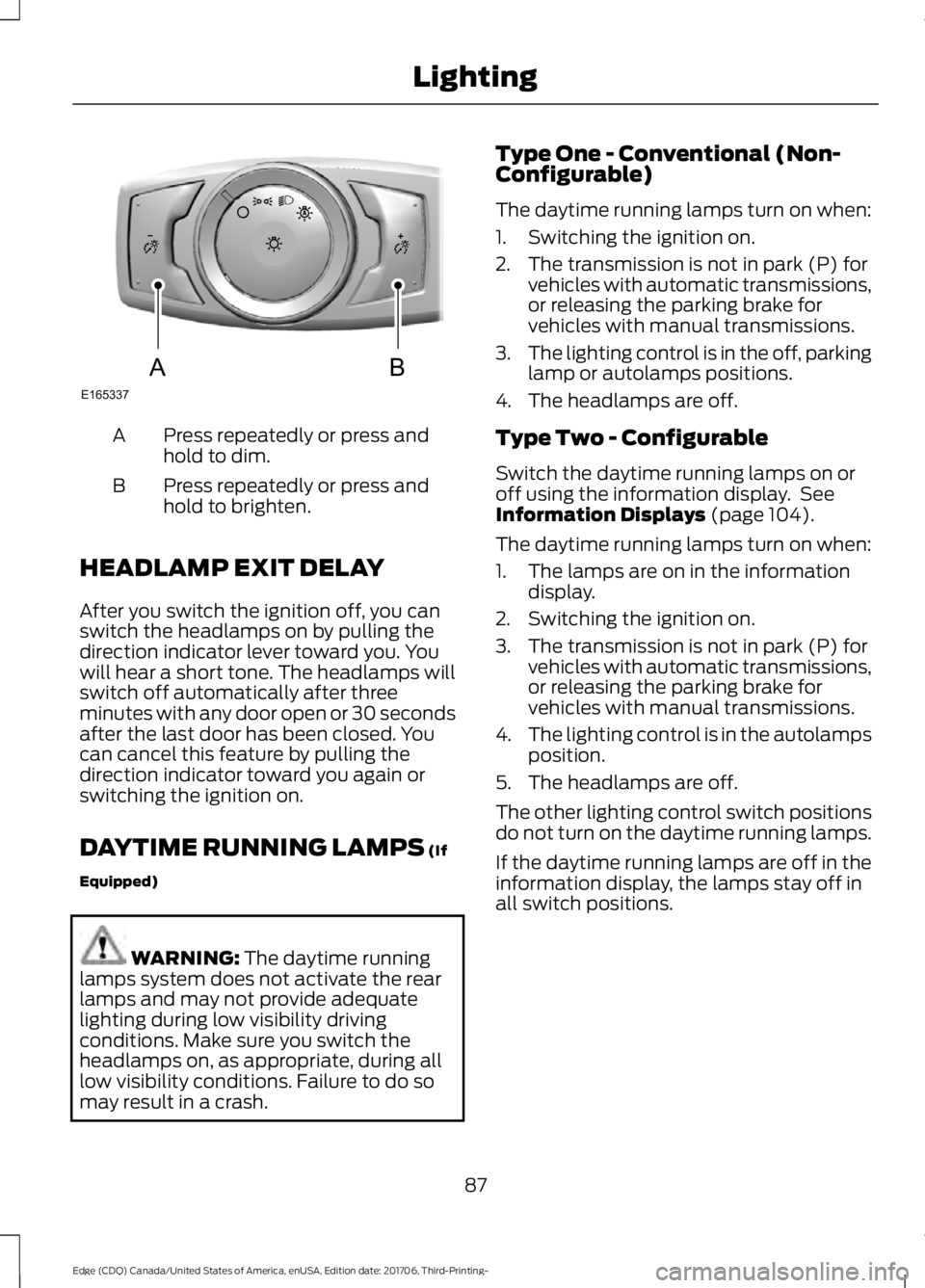
Press repeatedly or press and
hold to dim.
A
Press repeatedly or press and
hold to brighten.
B
HEADLAMP EXIT DELAY
After you switch the ignition off, you can
switch the headlamps on by pulling the
direction indicator lever toward you. You
will hear a short tone. The headlamps will
switch off automatically after three
minutes with any door open or 30 seconds
after the last door has been closed. You
can cancel this feature by pulling the
direction indicator toward you again or
switching the ignition on.
DAYTIME RUNNING LAMPS (If
Equipped) WARNING:
The daytime running
lamps system does not activate the rear
lamps and may not provide adequate
lighting during low visibility driving
conditions. Make sure you switch the
headlamps on, as appropriate, during all
low visibility conditions. Failure to do so
may result in a crash. Type One - Conventional (Non-
Configurable)
The daytime running lamps turn on when:
1. Switching the ignition on.
2. The transmission is not in park (P) for
vehicles with automatic transmissions,
or releasing the parking brake for
vehicles with manual transmissions.
3. The lighting control is in the off, parking
lamp or autolamps positions.
4. The headlamps are off.
Type Two - Configurable
Switch the daytime running lamps on or
off using the information display. See
Information Displays
(page 104).
The daytime running lamps turn on when:
1. The lamps are on in the information display.
2. Switching the ignition on.
3. The transmission is not in park (P) for vehicles with automatic transmissions,
or releasing the parking brake for
vehicles with manual transmissions.
4. The lighting control is in the autolamps
position.
5. The headlamps are off.
The other lighting control switch positions
do not turn on the daytime running lamps.
If the daytime running lamps are off in the
information display, the lamps stay off in
all switch positions.
87
Edge (CDQ) Canada/United States of America, enUSA, Edition date: 201706, Third-Printing- LightingE165337AB